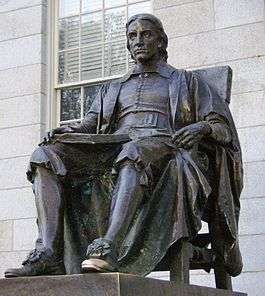Harvard Collection of Historical Scientific Instruments
Harvard University's Collection of Historical Scientific Instruments (CHSI),[1] established 1948, is "one of the three largest university collections of its kind in the world".[2] Waywiser, the online catalog of the collection, lists over 60% of the collection's 20,000 objects as of 2014.[3][4] The collection was originally curated by Mr. David P Wheatland in his office to prevent obsolete equipment from being cannibalized for its component parts and materials.[5]
A selection of instruments and artifacts from the collection is on permanent display in the Putnam Gallery on the first floor of the Harvard Science Center, which is free and open to the public on weekdays. In addition, rotating temporary exhibitions drawn from the collection are shown in the Special Exhibitions Gallery on the second floor, and a more modest Foyer Gallery space on the third floor.[1]
The CHSI includes a number of scientific instruments and demonstration apparatus purchased circa 1765 under the advice of Benjamin Franklin, to replace original equipment which had been lost in a disastrous fire which also destroyed the university's library in the original Harvard Hall.[6] A number of items on display in the Putnam Gallery are labeled as originally having been specified by Franklin. One of the larger items in the collection is the Harvard Mark I, a historic room-sized electromechanical computer commissioned in 1944, which is now permanently exhibited next to the central stairwell in the main lobby of the Science Center.
The collection continues to be expanded, under the supervision of a Director and several curators and technicians. Originally a part of the Harvard Library system, the CHSI is now affiliated with the Harvard Department of the History of Science, and is one of the four Harvard Museums of Science and Culture.[7] The CHSI is also affiliated with the American Alliance of Museums.[3]
A strategic plan has been developed to expand the CHSI's missions of preservation, education, research, and display, including expanded educational outreach and higher-profile public exhibitions.[3]
External links
References
- 1 2 "CHSI - The Collection of Historical Scientific Instruments, Harvard University". chsi.harvard.edu. Retrieved 2016-01-25.
- ↑ "Collection of Historical Scientific Instruments | Harvard Library". library.harvard.edu. Harvard University. Retrieved 2016-08-09.
- 1 2 3 "Strategic Plan: 2014-2019" (PDF). Collection of Historical Scientific Instruments. Harvard University. Retrieved 2016-08-09.
- ↑ "eMuseum". waywiser.rc.fas.harvard.edu. Retrieved 2016-01-25.
- ↑ "CHSI History". Collection of Historical Scientific Instruments. Harvard University. Retrieved 2016-07-14.
- ↑ Tomase, Jennifer (June 1, 2006). "'A How-To Guide' explores Ben Franklin's 'can-do' legacy". Harvard University Gazette. Retrieved 2016-08-09.
- ↑ "CHSI Affiliations". Collection of Historical Scientific Instruments. Harvard University. Retrieved 2016-07-14.
